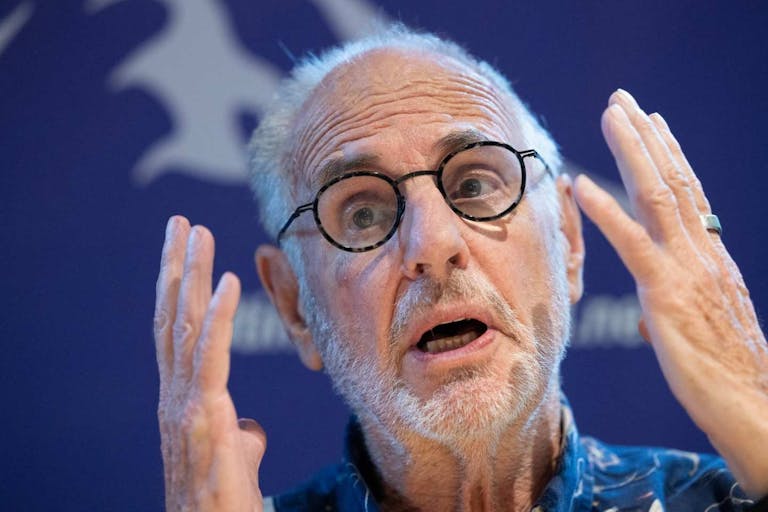
Activists arrested for blockading doors at TN Planned Parenthood
Nancy Flanders
·
This doctor is obsessed with teaching people how to kill themselves
Philip Nitschke, known as Dr. Death, recently taught more than 70 attendees of his suicide workshop how to commit suicide, showing off a "collar" he invented that people can wear around their necks to kill themselves. He seems to have devoted his life to validating people's fears about living with illness and disability, encouraging them to give in to their suicidal thoughts.
Philip Nitschke, also known as Dr. Death, recently spoke to an audience of 70 in London about ways to end their own lives.
Assisted suicide is currently not legal in England; however, Nitschke has held such a workshop before, and while at that time he was detained by police, he was released without charges.
He taught attendees how to die using gases, poisons, and mechanical devices, such as his Kairos collar, which a person puts around their neck to cut off the blood supply to their brain.
Philip Nitschke is the man behind Exit International, which he founded in 1997 to help people commit suicide. He also authored "The Peaceful Pill Handbook," which teaches people what pills to take to die. The creator of the Sarco suicide pod, which a person can enter and then push a button when they want to die, continues to find new ways to "help" individuals to kill themselves.
In September, he held a training workshop in London to teach people how to commit suicide. Assisted suicide is not legal in England, and though legislators are considering a bill to allow it in certain circumstances, currently, helping someone commit suicide carries a maximum penalty of 14 years in prison.
The last time Nitschke held this type of training in London, however, he was merely questioned by police and then released without charge. It makes sense, then, that he would have no fear of doing it again.
According to The Times, which sent a reporter to the training, those in attendance had to sign a disclaimer stating they were over the age of 50, had "decision-making mental capacity," and that the advice given by Nitschke was "not intended as advice or encouragement."
"But seemingly unworried by possible legal threats," wrote The Times, "Nitschke appeared relaxed as he sat behind a desk at the front of the hall next to one of his latest inventions —a large 'collar' worn around the neck that can be used to bring on death."
The training workshop was three hours long, and involved Nitschke telling attendees about different methods of committing suicide, including by gases, mechanical devices, and poisons. He also discussed his first invention, which injected people with deadly drugs at the push of a keyboard button, as well as his now-infamous suicide pod, which he created using 3D printing. After the person gets inside and pushes a button, the pod fills with gas, reducing oxygen levels until the person loses consciousness and then dies.
In September 2024, an American woman was the first to use Nitschke's pod in Switzerland. Police seized the pod and arrested everyone present, including Dr. Florian Willet, who was jailed for 70 days and later released without charge. He killed himself after his release.
Article continues below
Dear Reader,
Have you ever wanted to share the miracle of human development with little ones? Live Action is proud to present the "Baby Olivia" board book, which presents the content of Live Action's "Baby Olivia" fetal development video in a fun, new format. It's perfect for helping little minds understand the complex and beautiful process of human development in the womb.
Receive our brand new Baby Olivia board book when you give a one-time gift of $30 or more (or begin a new monthly gift of $15 or more).
Nitschke also played a video of the American woman's death for the attendees of his workshop, and told them he has "printed" a pod that can fit two people inside, so a couple can die together. It's part of the romanticizing of suicide that has been taking place in recent years, convincing couples that dying together is akin to a Shakespearean scene.
As for the collar, it's called the Kairos, and it appears to kill a person by cutting off blood flow, and thereby oxygen, to the brain.
Nitschke claims to believe that "‘it is the fundamental human right of every adult of sound mind, to be able to plan for the end of their life in a way that is reliable, peaceful & at a time of their choosing."
But having suicidal ideations is a sign that a person is not of "sound mind." And no method of suicide can truly be considered "peaceful."
In some cases, the drugs administered to the person paralyze him so that he appears peaceful to onlookers, while another drug causes him to drown as his lungs fill with fluid. Pushing a button alone in a pod seems stressful, especially if no one around you appears to care that you are about to kill yourself, and being strangled to death by a machine also seems quite traumatic.
Suicide can not be both a tragedy for the young and able-bodied and a right for the elderly, the disabled, and the chronically ill. It is always a tragedy, and should always be something society works to prevent, especially in those who have lost hope, who feel their lives are no longer of value or worth, and whom research has shown may be experiencing treatable depression.
As the College of Psychiatrists explained, "Where physician-assisted suicide and euthanasia are available, many requests stem not from intractable pain, but from such causes as fear, depression, loneliness and the wish not to burden carers.” Their study found that when loneliness and depression are treated, people often no longer wish to die by assisted suicide.
What people facing the end of life or a long-term illness need is palliative care, psychological care, pain management, and social supports — not encouragement to die.
Live Action News is pro-life news and commentary from a pro-life perspective.
Contact editor@liveaction.org for questions, corrections, or if you are seeking permission to reprint any Live Action News content.
Guest Articles: To submit a guest article to Live Action News, email editor@liveaction.org with an attached Word document of 800-1000 words. Please also attach any photos relevant to your submission if applicable. If your submission is accepted for publication, you will be notified within three weeks. Guest articles are not compensated (see our Open License Agreement). Thank you for your interest in Live Action News!

Nancy Flanders
·
International
Angeline Tan
·
Issues
Cassy Cooke
·
Issues
Sheena Rodriguez
·
Issues
Cassy Cooke
·
Issues
Angeline Tan
·
Activism
Nancy Flanders
·
Opinion
Nancy Flanders
·
Investigative
Nancy Flanders
·
Analysis
Nancy Flanders
·
Politics
Nancy Flanders
·